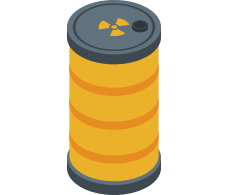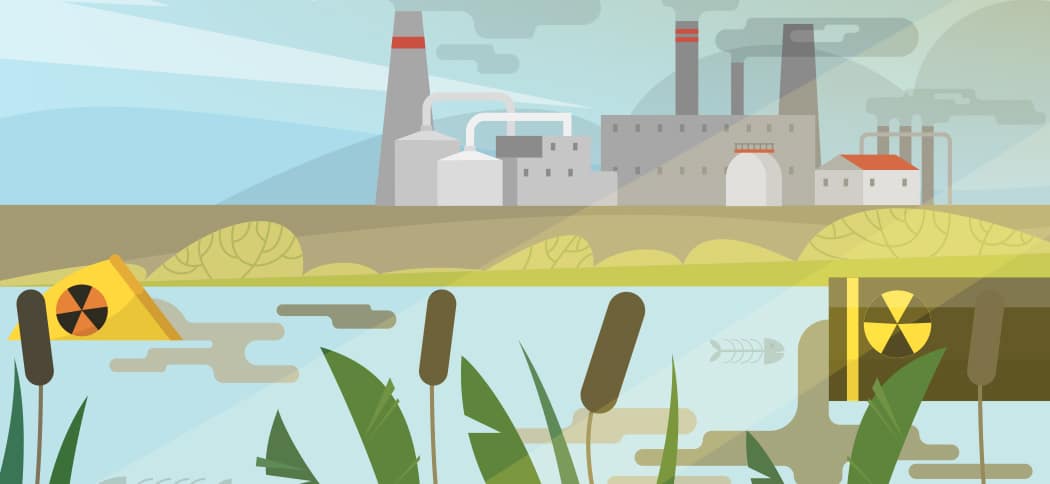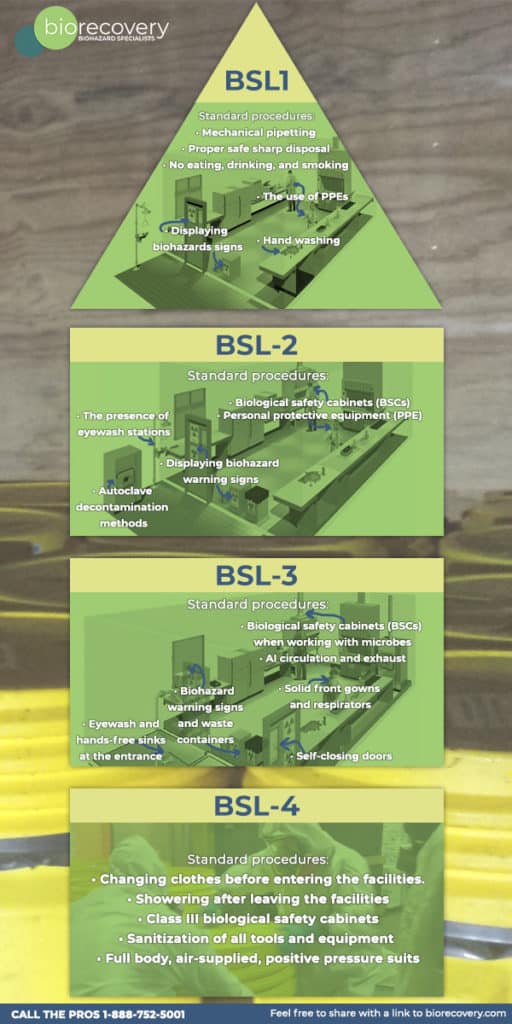Key-Points
What is Biohazard Safety?
The 4 Biohazard Levels
Biological Hazards Can Be Considered Waste
All Hazardous Waste Must be Disposed of Properly

Biohazard Safety Levels (BSL), also called biohazard levels or biosafety levels, are designed to help protect the environment, laboratory staff members, and the surrounding community.
These safeguards have been officially categorized from one to four by the CDC. The Centers for Disease Control and Prevention (CDC) differentiate these risks based on the severity of disease, infectivity, transmissibility, and the type of work being carried out at any given time. Other determining factors are the exposure method and the source of a microbe or agent.
Biosafety levels are important because they help determine the nature of work to be undertaken within a lab setting. In the long run, BSLs dictate how facilities should be designed and which safety equipment to stock. They aren't just for laboratory members: they also provide structure and guidelines on how biohazard technicians like us should handle these situations.
What is Biohazard Safety?
Biosafety refers to the application of defined training and safety apparatus, practices and procedures, healthcare infrastructure, and suitable occupational health plans to effectively manage biological hazards and infectious microorganisms.
The aim is to safeguard the people working with harmful biological materials. Biosafety measures also ensure that the environment, the general public, and wildlife are protected from dangerous biological agents.
These biosafety structures are typically executed within lab settings. For example, these frameworks can be found in environmental research and teaching laboratories based on three primary concepts: biological hazard, biocontainment, and bioprotection.
The use of Biohazard Safety Levels (BSL) in laboratories is important. These measures help protect employees, the general public, and the environment from biological hazards.
The four biohazard safety levels were created due to the need for enhanced biosafety.
The 4 Biohazard Levels
The four biohazard levels are explained below. These measures are designed to help enhance safety within laboratories by protecting laboratory staff members and the surrounding community and environment.
BSL-1
These hazards are placed at the lowest section of the biosafety pyramid. This level contains the different settings that apply in labs where people work with low-risk microbes. Low-risk microbes are considered the least dangerous to healthy adults. For example, nonpathogenic Escherichia coli (E. coli) is considered a low-risk microbe.
The personnel in this section also don't use any special contaminant equipment. Examples of requirements here are:
- Mechanical pipetting
- Hand washing
- The handling of safe sharps
- The setting up of biohazards signs
- The ban on eating, drinking, and smoking
- The use of PPEs
BSL-2
This level applies to labs that work with human disease-causing agents. These agents are typically infections or pathogenic organisms) that cause moderate health hazards such as HIV and Staphylococcus aureus.
It is vital to note that BSL-1 and BSL-2 labs have similar microbial practices. However, BSL-2 labs go a step further to demand enhanced care by lab members.
Examples of requirements here are:
- The use of suitable personal protective equipment.
- The following of all dangerous procedures within biological safety cabinets (BSCs).
- The setting up of biohazard warning signs.
- The availability of autoclave alternative decontamination methods.
- The presence of eyewash stations.
BSL-3
This level enhances the measures contained in the BSL-1 and BSL-2 levels. BSL-3 measures are found in labs where staff members work on indigenous or exotic microbes. These microbes can cause lethal diseases when inhaled. Examples are yellow fever, TB bacteria, and the West Nile virus.
Here, ongoing work has to be regulated by governmental agencies. Typical requirements include:
- The wearing of standard personal protective equipment
- The presence of eyewash and hands-free sinks at the entrance
- The use of BSCs when working with microbes
- The use of proper PPEs
- The presence of self-closing doors
- Ai circulation measures where exhaust air does not reenter the lab
BSL-4
The final level alludes to labs where employees work with exotic and highly dangerous microbes. These microbes are fatal due to the lack of associated treatment measures or vaccines. Examples are the Marburg and Ebola viruses.
On top of BSL-1, BSL-2, and BSL-3 requirements, these measures should be present:
- The change of clothes before entering the facilities.
- Showering after leaving the facilities
- The presence of Class III biological safety cabinets
- The sanitization of all tools and equipment after leaving the facilities
- The wearing of full body, air-supplied, positive pressure suits
Biological Hazards Can Be Considered Waste
A biological hazard is an organism or substance that is considered harmful to human health. It is vital to note that certain materials produced by organisms can be considered biological hazards. These organisms are mostly associated with foodborne disease outbreaks.
Examples of biohazards are viruses, spores, pathogenic microorganisms, io-active substances, toxins, and fungi.
Sometimes, biological hazards can occur in the form of waste products. Types are infectious waste, pathological waste, animal waste, discarded vaccines, and used sharps.
Biocontainment is a biorisk managerial function that focuses on confining infectious organisms and poisons to cut the risk of exposure. The process is meant to protect lab workers from the accidental contraction of the diseases caused by biological hazards. For instance, an organization's management can tell its employees to wear PPE suits and masks.
It’s important to note that hazards can mean different things. There is also a difference between biological hazards and HAZMAT (hazardous materials). While biohazardous wastes are organisms or substances that are considered harmful to human health, HAZMAT refers to all the materials that can risk the health of people, as well as environmental wellbeing. Examples of hazardous materials are fuels, toxic chemicals, and nuclear wastes. Others can be chemical or radiological agents.
All Hazardous Waste Must Be Dispose of Properly
Hazardous material (HAZMAT) has its own protocol for disposal, according to the type of waste it is. Biohazard waste (biohazards) should also be collected and disposed of following a different protocol. For example, you should not leave biohazardous waste in unsecured public areas. Lab personnel should also be at the forefront of removing these products from such areas.
Researchers, genetic engineers, environmentalists, policymakers, and administrators have enhanced the need for biohazard safety. In particular, governmental bodies such as the Centers for Disease Control and Prevention (CDC) have created specific guidelines that cleanup companies need to follow for protection and disposal. The aim is to reduce unexpected challenges to public health and the environment.
These measures are also important in helping enhance biosecurity and prevent bioterrorism. Therefore, you should always consider the specific biosafety measures within your company as these have been developed for your protection.
Call The Pros
To dispose of or clean up after any of these situations, you'll want a professional and team player in your corner. Call Bio Recovery, a top rated professional biohazard waste cleanup company that has been handling and disposing materials in these situations for over 20 years.
Call us any time for immediate, 24/7, discrete assistance.
Share this Post

